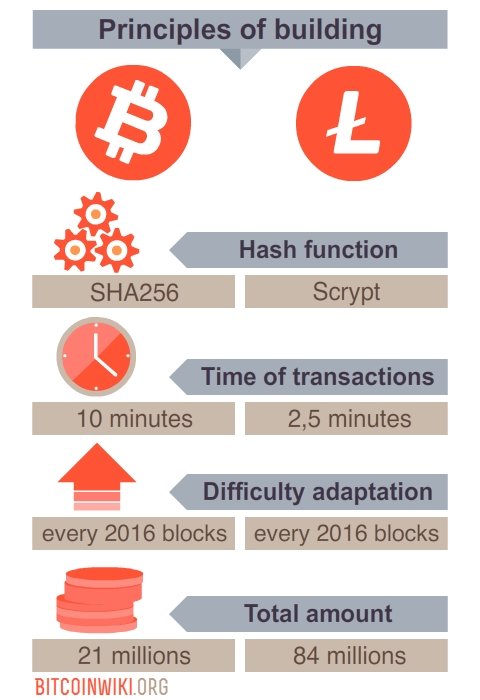Bitcoin and Litecoin comparison
Contents
SHA256 mining vs scrypt mining

For purposes of proof-of-work Bitcoin network uses highly parallelized SHA256 hash function. Litecoin in turn uses Scrypt instead of SHA256 performance of which is dependant on access to large reserves of memory so that running several Scrypt-processes on current generation GPUs is highly resource-intensive. This also means that building ASIC designs for Scrypt is far more difficult and expensive task than for SHA256. Mining LTC with CPUs isn’t profitable because of their little memory resource.
Advantages of Scrypt:
- Getting started with LTC mining is far more cheap compared to BTC. Any PC owner can start to mine and support the network. It’s even possible to mine with CPU though this process is ineffective. It is recommended to use GPU for LTC acquisition. High accessibility of mining devices allows the LTC network to be far more decentralized.
- With mining principles of BTC there’s always a danger of some person or group to invest immense amount of money into ASIC devices and thus centralize the mining process. The Scrypt protocol requires high amounts of memory to mine fast and memory is the most expensive component when building ASIC designs.
- LTC mining sowtware can be easily built into web sites, which allows random users to support LTC network with free CPU cycles while browsing.
Downsides:
- Botnet attacks. Botnets with high hash-rates (compared to entire network) can try and conduct a 51% attack. Because of lack of major miners in the network it’s easier to realize such an attack in LTC than in BTC.
Decreased time of transactions
On average the Litecoin network finds a single block once in every 2,5 minutes, compared to 10 minutes in BTC. Accordingly transaction processing and approval is conducted much faster.
Advantages:
- Huge number of people want to see their money as fast as possible.
- Fast block discovery allows shops or services to accept transactions with 2 5-minutes approvals without having to make the client wait. (In Bitcoin network they have to wait for at least one approval for ten minutes).
- Because blocks are discovered so frequently more miners earn their rewards and can spend them faster than BTC.
Downsides:
- The more blocks the longer the blockchain. The longer the blockchain the more space it takes in user’s PC memory.
- If the amount of transactions rises significantly then the time needed to approve signature in every block rises accordingly.
- Security problems, which include much cheaper implementation of 51% attack than in BTC.
Difficulty adaptation
In Litecoin network difficulty changes every 2016 blocks (just like in Bitcoin) but because blocks are found four times more frequently the difficulty is adapted every 3.5 days.
Advantages:
- If most of Bitcoin network switches off reaching difficulty change point will be rather hard and long. In Litecoin this process will happen quicker.
Downsides:
- Unstable difficulty may provoke users’ switching from one blockchain to another.
- Lower protection from attacks that deliberately lower difficulty.
- Small intervals between difficulty changes may lead to inaccurate difficulty rates.
Total amount of “coins” in network
Entire amount of Litecoins to be emitted is four times more than of Bitcoins (84 millions compared to 21). Initial reward for a mined blok in Litecoin network is 50 LTC. Every 840000 blocks the amount of coins per block is cut in half.
Principal concepts Litecoin:
1. Transactions are 4 times more fast than in Bitcoin. The network pays for that with somewhat decreased protection from attacks.
2. Low barrier to entry. User just needs CPU or GPU to start mining.
3. Coins amount is four times more than in Bitcoin network.
To sum this up, Litecoin to Bitcoin is what silver is to gold – a less precious currency which is easier to mine and easier to operate.